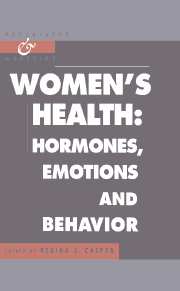Book contents
- Frontmatter
- Contents
- Preface
- 1 Growing up female
- 2 Reproduction and its psychopathology
- 3 Women's sexual function and dysfunction
- 4 Gender differences in brain morphology and in psychiatric disorders
- 5 Thyroid hormones in major depressive disorder and bipolar disorder
- 6 The hypothalamic-pituitary-adrenocortical system
- 7 The cost of starvation: Eating disorders
- 8 Coronary artery disease and women: Estrogens and psychosocial and lifestyle risk factors
- 9 The psychophysiology of breast cancer: Disease, hormones, immunity, and stress
- 10 The psychopharmacology of women
- 11 Intervention trials concerned with disease prevention in women
- References
- Index
9 - The psychophysiology of breast cancer: Disease, hormones, immunity, and stress
Published online by Cambridge University Press: 08 February 2010
- Frontmatter
- Contents
- Preface
- 1 Growing up female
- 2 Reproduction and its psychopathology
- 3 Women's sexual function and dysfunction
- 4 Gender differences in brain morphology and in psychiatric disorders
- 5 Thyroid hormones in major depressive disorder and bipolar disorder
- 6 The hypothalamic-pituitary-adrenocortical system
- 7 The cost of starvation: Eating disorders
- 8 Coronary artery disease and women: Estrogens and psychosocial and lifestyle risk factors
- 9 The psychophysiology of breast cancer: Disease, hormones, immunity, and stress
- 10 The psychopharmacology of women
- 11 Intervention trials concerned with disease prevention in women
- References
- Index
Summary
Introduction
Breast cancer is a major public health problem in the United States, with an estimated 182,000 new cases occurring in women in 1994. It is the leading cause of cancer death among women 54 years of age or younger and overall accounts for 18 percent of female cancer deaths (Boring et al., 1994). At the time of diagnosis, in 47 percent of women with breast cancer the disease has spread to the lymph nodes or beyond, compared with 72 percent of those with ovarian cancer. Early detection of both diseases may allow for cure in up to 95 percent of breast cancers (Tabar et al., 1992) and 90 percent of ovarian cancers (Young et al., 1990a).
For most women, a diagnosis of breast cancer marks the beginning of a lifelong struggle. The disease and treatments become physical-psychological stressors whose effects linger long after the individual is tumor-free. The effects are often widespread. Breast cancer is associated with anxiety and depression, not only in those who are affected but in their families and loved ones as well (Holland, 1989). Newer studies in animals indicate that marked stress can shift the neuroendocrine axis. For example, increases in cortisol levels are associated in animals with more rapid tumor growth (Sapolsky and Donnelly, 1985; Ben-Eliyahu et al., 1991). Effects of stress on components of the immune system that are associated with cancer progression, such as natural killer cells (Levy et al., 1987), have also been documented (Kennedy, Kiecolt-Glaser, and Glaser, 1988). In some studies, serious life stress such as bereavement or job loss has been found to be associated with higher risk of relapse of breast cancer (Ramirez, 1989).
Keywords
- Type
- Chapter
- Information
- Women's HealthHormones, Emotions and Behavior, pp. 166 - 191Publisher: Cambridge University PressPrint publication year: 1997



